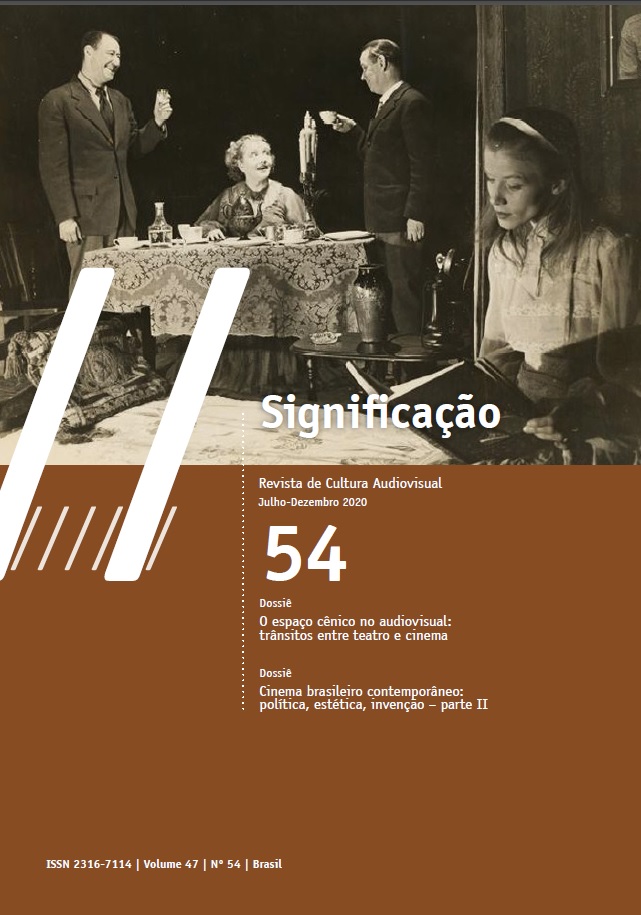Da ópera para o cinema, do cinema para a ópera: a arte do ator-cantor
DOI:
https://doi.org/10.11606/issn.2316-7114.sig.2020.164518Palavras-chave:
Atuação, Cinema silencioso, Ópera, TeatroResumo
Neste artigo, consideramos o aspecto da atuação no cinema silencioso de estrelas da ópera com o objetivo de trazer questionamentos sobre uma possível influência das experiências desses artistas em sua atuação operística no sentido de um maior naturalismo. Colocando a atuação nos palcos dentro de uma esfera mais ampla, estudamos o “pictorialismo” (as poses), comum no teatro não musicado do final do século XIX e adotado também na ópera. Para nossas reflexões, usamos um caso com boa documentação de exibição cinematográfica, o da estrela do Metropolitan Opera House, a soprano Geraldine Farrar, como Carmen, no filme homônimo de 1915 de Cecil B. DeMille.
Downloads
Referências
ALTMAN, R. “Early film themes: Roxy, Adorno, and the problem of cultural capital”. In: GOLDMARK, D.; KRAMER, L.; LEPPERT, R. (org.). Beyond the soundtrack: representing music in cinema. Los Angeles: University of California Press, 2007. p. 205-224.
ANDERSON, G. B. “Geraldine Farrar and Cecil B. DeMille: the effect of opera on film and film on opera in 1915”. In: PERRIAM, C.; DAVIES, A. (ed.). Carmen: from silent film to MTV. Amsterdam: Editions Rodopi B.V., 2005. p. 23-35.
AUMONT, J. O cinema e a encenação. Lisboa: Texto & Grafia, 2008.
BRANSTETTER, L. Angels and Artic Monkeys: a study of pop-opera crossover. 2006. Dissertação (Mestrado em Música) – Universidade de Cincinnati, Cincinnati, 2006.
BREWSTER, B.; JACOBS, L. Theatre to cinema: stage pictorialism and the early feature film. New York: Oxford University Press, 2016. Disponível em: https://bit.ly/3i7Faw0. Acesso em: 26 jun. 2020.
CHION, M. La musique au cinéma. 2. ed. rev. e aum. Paris: Fayard, 2019.
COSTA, F. C. “Primeiro Cinema”. In: MASCARELLO, F. (org.). História do Cinema Mundial. Campinas: Papirus, 2006. p. 17-52.
ESSE, M. “The silent diva: Farrar’s Carmen”. In: HENSON, K. Technology and the diva: sopranos, opera, and media from romanticism to the digital age. New York: Cambridge University Press, 2016. p. 89-103.
FARRAR, G. “The Story of my Life”. Photoplay, Chicago, 1919. Disponível em: https://bit.ly/3i5nsZQ. Acesso em: 7 nov. 2019.
FRYER, P. The opera singer and the silent film. Jefferson: Mc Farland, 2005.
FRYER, P.; USOVA, O. Lina Cavalieri: the life of opera’s greatest beauty, 1874-1944. Jefferson: Mc Farland, 2004.
GUNNING, T. The cinema of attraction[s]: early film, its spectator and the avantgarde. In: STRAUVEN, W. (ed.). The cinema of attractions reloaded. Amsterdam: Amsterdam University Press, 2006. p. 381-388.
HENSON, K. Opera acts: singers and performance in the late nineteenth century. Cambridge: Cambridge University Press, 2015.
HICKS, A. Singer and actor: acting technique and the operatic performer. Milwaukee: Amadeus Press, 2011.
IRINA, M. The spell of live performance: HD opera and liveness today. 2016. Tese (Doutorado em Filosofia) – Carleton University Ottawa, Ottawa, 2016.
JELGERHUIS, J. Theoretische lessen over de gesticulatie en mimiek, gegeven aan de kweekelingen van het fonds ter opleiding en onderrigting van tooneelkunstenaars aan den Stads Schouwburgte Amsterdam. Amsterdam: P. Meijer Warnars, 1827. Disponível em: https://bit.ly/38gLI73. Acesso em: 30 jun. 2020.
JOE, J. Opera as soundtrack. Surrey: Ashgate, 2013.
LALEU, A. “Dans le monde de l’opéra, le physique prime désormais sur la voix” Slate.fr, Paris, 22 fev. 2018, 9:41. Disponível em: https://bit.ly/3eCzDeH. Acesso em: 15 nov. 2019.
LEVINE, L. Highbrow/Lowbrow: the emergence of cultural hierarchy in America. Cambridge: Harvard University Press, 1990.
MARON, D. Para além da ópera: Tito Schipa e sua presença no Brasil no início do século XX. 2018. Dissertação (Mestrado em Música) – Universidade Federal do Rio de Janeiro, Rio de Janeiro, 2018.
NASH, E. Geraldine Farrar: opera’s charismatic innovator. 2. ed. Jefferson: McFarland, 2012.
PAULIN, S. “Richard Wagner and the fantasy of cinematic unity: the idea of Gesamtkunstwerk in the History and Theory of Film Music”. In: BUHLER, James; FLINN, C.; NEUMEYER, D. Music and Cinema. Middletown: Wesleyan University Press, 2000. p. 58-84.
PEARSON, R. Eloquent gestures: the transformation of performance style in the Griffith Biograph films. Berkeley: University of California Press, 1992.
PEREIRA, C. E. A música no cinema silencioso no Brasil. Rio de Janeiro: Museu de Arte Moderna, 2014.
RINDOM, D. “Celluloid diva: staging Leoncavallo’s Zazà in the cinematic age”. Journal of the Royal Musical Association, Cambridge, n. 144, v. 2, p. 287-321, 2019.
SCHROEDER, D. Cinema’s illusions, opera’s allure: the operatic impulse in film. New York: Continuum International Publishing Group Inc., 2002.
SIDDONS, H. Practical illustrations of rhetorical gesture and action. London: Sherwood, Neely and Jones, 1822.
TAMBLING, J. “Film aspiring to the condition of opera”. In: TAMBLING, J. Opera, ideology and film. Basingstoke: Palgrave Macmillan, 1987. p. 41-67.
Downloads
Publicado
Edição
Seção
Licença
Copyright (c) 2020 Luíza Beatriz Alvim, Diana Maron

Este trabalho está licenciado sob uma licença Creative Commons Attribution-NonCommercial 4.0 International License.
Autores que publicam nesta revista concordam com os seguintes termos:- Autores mantém os direitos autorais e concedem à revista o direito de primeira publicação, com o trabalho simultaneamente licenciado sob a Licença Creative Commons Attribution que permite o compartilhamento do trabalho com reconhecimento da autoria e publicação inicial nesta revista para fins não comerciais.
- Autores têm autorização para assumir contratos adicionais separadamente, para distribuição não-exclusiva da versão do trabalho publicada nesta revista (ex.: publicar em repositório institucional ou como capítulo de livro), com reconhecimento de autoria e publicação inicial nesta revista.
















